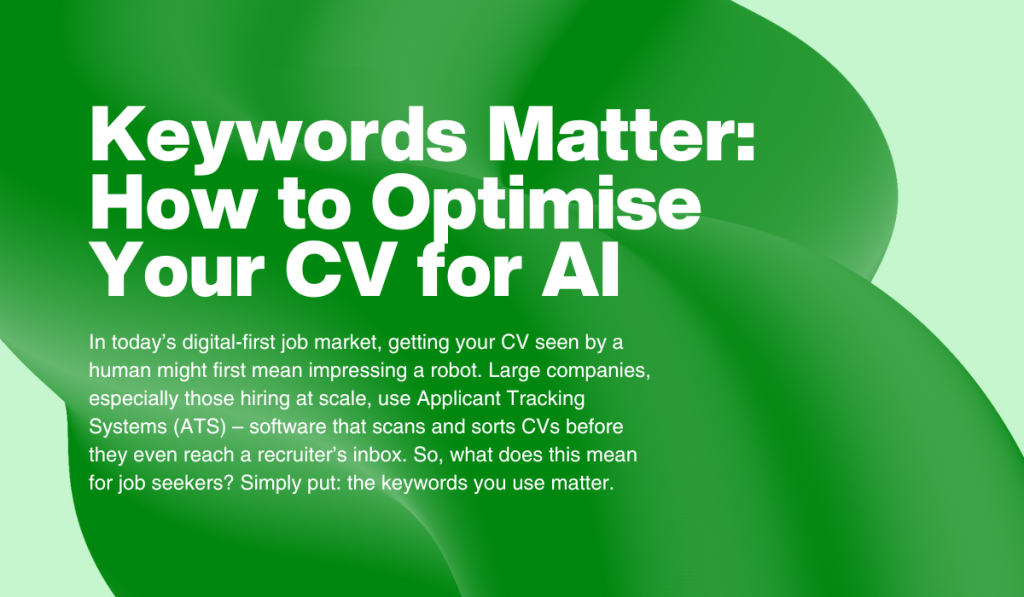In today’s digital-first job market, getting your CV seen by a human might first mean impressing a robot. It is a reality that today, the first pair of eyes that sees your CV might not be human. Large companies, especially those hiring at scale, use Applicant Tracking Systems (ATS) – software that scans and sorts CVs before they even reach a recruiter’s inbox. So, what does this mean for job seekers? What does it mean to “optimise for AI”? Simply put: the keywords you use matter.
Here’s how to tailor your CV and optimise for AI so it works smarter, not harder – and gets past those digital gatekeepers.

What is an ATS, and why does it matter?
An ATS (Applicant Tracking System) is designed to streamline the hiring process. It helps recruiters filter through large volumes of applications by scanning for relevant skills, experience, and keywords related to the role.
If your CV doesn’t align with the job description – or uses different language to describe the same thing – it might not make it through to the next stage, no matter how well-suited you are.
Step 1: Use the job description as your guide
Think of each job post as a cheat sheet. The key qualifications, responsibilities, and soft skills listed in the job ad give you a clear idea of what the employer values most. Reflect this language in your CV – naturally, of course. When trying to optimise for AI, don’t fall into the trap of keyword overkill – make sure it still sounds as natural as possible! If the job ad mentions “project coordination,” use that phrase (if it fits your experience) instead of a synonym like “project support.”
When you optimise for AI, don’t think of it as tricking the system – rather it’s about speaking the same language.
Step 2: Focus on hard skills and industry terms
Certain phrases are more likely to be picked up by an ATS than others. These include software tools (like “AutoCAD” or “Excel”), certifications (like “CPA” or “IELTS”), and methodologies (like “Agile” or “SEO”). Make sure you’re using recognised terminology and spelling out acronyms when possible, at least once (e.g. “Search Engine Optimisation (SEO)”).
If you’re applying for a job in a technical or specialised field, the right jargon can make all the difference.
Step 3: Don’t forget soft skills – but be specific
While soft skills like “teamwork” or “communication” do show up in job ads, they’re often too vague on their own. Support them with context. Instead of listing “leadership” in isolation, write something like: “Led a team of five to deliver a marketing campaign under a tight deadline.”
This not only improves your chances with ATS, but also gives recruiters and hiring managers more to go on once your CV lands in their hands.
Step 4: Keep formatting simple
Some creative CV designs look great to the human eye, but confuse ATS software. Stick to clear section headings (like “Work Experience” or “Skills”), avoid text boxes or tables, and use standard fonts. A PDF is generally fine, but if the job ad specifies a format, follow it.
Your CV doesn’t need to be flashy – it needs to be readable.
Step 5: Test it out
There are free tools online that mimic how an ATS might read your CV. They won’t guarantee results, but they can give you a good idea of whether your document is keyword-optimised. Another simple tip? Copy the job description into a word cloud generator and see which words appear most frequently – then make sure those same words appear in your CV, where relevant.
A small tweak can make a big impact
Optimising your CV for AI might sound technical, but at its core, it’s about clarity. It’s about understanding the role, matching your skills to what’s asked, and making it easy for both bots and humans to see what you bring to the table.
Your experience is valuable – make sure it gets noticed.
Need more CV tips?
Explore our blog for more practical advice to help you put your best foot forward: keepmeposted.com.mt/blog



